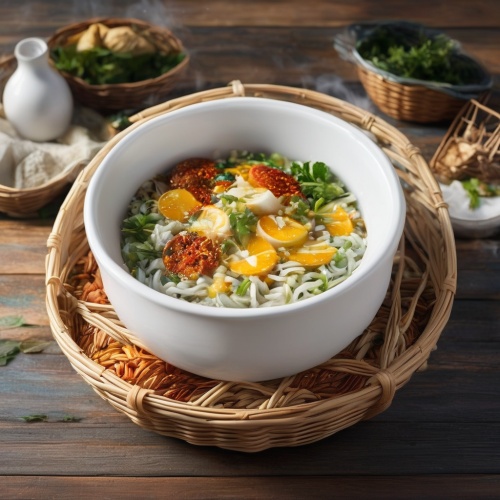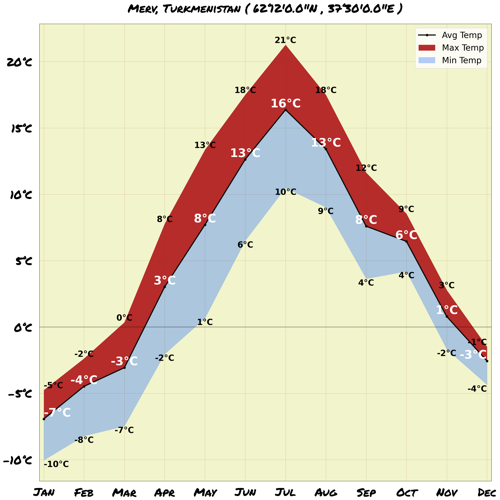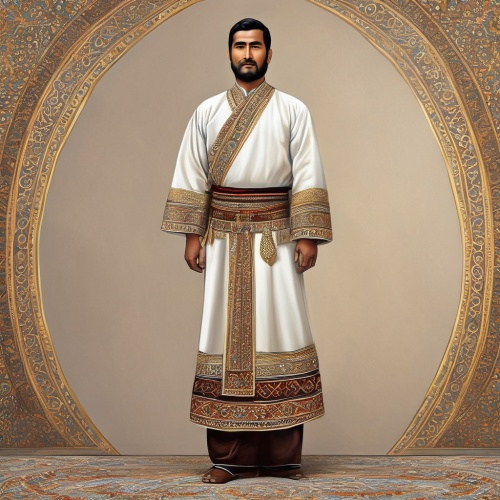Understand
Discover the hidden oasis of Merv, nestled in the vast Karakum Desert. Situated at the crossroads of the Ama Darya River and the main route to Bukhara and Samarkand, this oasis spans an impressive area of 86 x 75 km. Delve into its fascinating past as you explore Bronze Age centers dating back to 2500 BC, located in the northern part of the oasis. Witness the birth of a historic urban center that emerged around 500 BC in the eastern part of the oasis. This bustling hub consisted of several fortified cities, covering over 1200 hectares. One of the oldest cities, known as Erk Kala, traces its origins back to the Achaemenid period (519 to 331 BC), as attested by the famous inscription of Darius the Great at Bisitun in Iran. Prepare to be amazed by the intertwining of cultures as Merv became part of Alexander the Great's empire. According to the accounts of the renowned scholar Pliny the Elder, it is believed that the city was founded by Alexander himself. Later, the city was rebuilt by the Seleucid king Antiochus I Soter (281 to 261 BC) and named Margiana Antiochia. This ancient city, identified with Erk Kala and Giaur Kala, witnessed the rise and fall of empires, enduring through the Parthian, Sasanian, and early Islamic periods. Traces of the past are evident as it is suggested that Greek and Roman soldiers who survived the Roman defeat against the Parthians at Carrhae in 53 BC found refuge and settled in Margiana. Embrace the influence of Islamic culture, which flourished after the demise of the last Sasanian King Yazdigird III in 651 AD. Marvel at the medieval city that stood proudly during the Seljuk period, located west of Giaur Kala. This magnificent city, encompassing over 600 hectares, served as the capital of the mighty Seljuk Empire (11th to 13th century) and attracted scholars and luminaries from all corners of the Islamic world. Among them were the famed astronomer and poet Omar Khayyam and the esteemed geographer Yaqut al Hamavi. However, history took an unexpected turn when the Mongols swept through Merv, ravaging the city in 1221. Yet, the resilient spirit of Merv endured, becoming a part of the empire of Timur (1370-1405). Witness the rebirth of the city as Abdullah Khan Kala was constructed by Shah Rukh (1408-1471) on a new site to the south of Giaur Kala. Prepare to be swept away by the rich tapestry of history and adventure that awaits you in the ancient oasis of Merv.
Map & Climate
Popular Foods
 Plov (also spelled as plov or pilaf), sometimes referred to as the "national dish of Turkmenistan," is a rice dish that typically includes beef or lamb, carrots, onions, and spices such as cumin and coriander. The dish is cooked slowly on low heat, allowing the flavors to combine and the rice to become infused with the other ingredients. Plov is often served with a side of yogurt and pickles, which provide a tangy contrast to the richness of the main dish.
Plov (also spelled as plov or pilaf), sometimes referred to as the "national dish of Turkmenistan," is a rice dish that typically includes beef or lamb, carrots, onions, and spices such as cumin and coriander. The dish is cooked slowly on low heat, allowing the flavors to combine and the rice to become infused with the other ingredients. Plov is often served with a side of yogurt and pickles, which provide a tangy contrast to the richness of the main dish. Manty is a type of traditional dumpling found throughout Central Asia, including Turkmenistan. These small, round dumplings are made from unleavened dough and filled with a mixture of ground meat, typically beef or lamb, and herbs. They can be boiled, fried, or steamed and are often served with a sour cream or yogurt sauce, as well as a side of fresh vegetables. Manty are a versatile dish, enjoyed at various times of day, from breakfast to dinner.
Manty is a type of traditional dumpling found throughout Central Asia, including Turkmenistan. These small, round dumplings are made from unleavened dough and filled with a mixture of ground meat, typically beef or lamb, and herbs. They can be boiled, fried, or steamed and are often served with a sour cream or yogurt sauce, as well as a side of fresh vegetables. Manty are a versatile dish, enjoyed at various times of day, from breakfast to dinner. Chaukarma is a dish consisting of thinly sliced lamb, normally served raw but can also be cooked, mixed with various herbs and spices, and wrapped in a flatbread called non. This dish, which originates from the Turkmen desert, is a popular street food. It's often eaten during special occasions or festivals, reflecting the nomadic culture of the region. Chaukarma offers a unique blend of flavors, showcasing the simplicity and heartiness of Turkmen cuisine.
Chaukarma is a dish consisting of thinly sliced lamb, normally served raw but can also be cooked, mixed with various herbs and spices, and wrapped in a flatbread called non. This dish, which originates from the Turkmen desert, is a popular street food. It's often eaten during special occasions or festivals, reflecting the nomadic culture of the region. Chaukarma offers a unique blend of flavors, showcasing the simplicity and heartiness of Turkmen cuisine.




Comments
NO COMMENTS